
Hillbilly is a term for people who dwell in rural, mountainous areas in the United States, primarily in the Appalachian region and Ozarks. As people migrated out of the region during the Great Depression, the term spread northward and westward with them.

Bluegrass music is a genre of American roots music that developed in the 1940s in the Appalachian region of the United States. The genre derives its name from the band Bill Monroe and the Blue Grass Boys. Like mainstream country music, it largely developed out of old-time string music, though in contrast, it is traditionally played exclusively on acoustic instruments and also has roots in traditional English, Scottish and Irish ballads and dance tunes, as well as in blues and jazz. It was further developed by musicians who played with Monroe, including 5-string banjo player Earl Scruggs and guitarist Lester Flatt. Monroe characterized the genre as "Scottish bagpipes and ole-time fiddlin'. It's a part of Methodist, Holiness and Baptist traditions. It's blues and jazz, and it has a high lonesome sound."
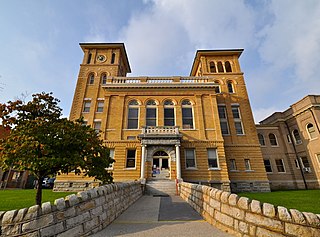
Wise County is a county located in the U.S. state of Virginia. The county was formed in 1856 from Lee, Scott, and Russell Counties and named for Henry A. Wise, who was the Governor of Virginia at the time. The county seat is in Wise.
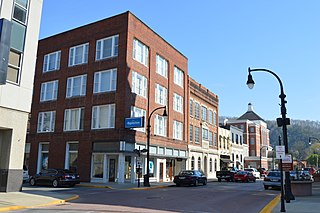
Pikeville is a home rule-class city in and the county seat of Pike County, Kentucky, United States. The population of Pikeville was 7,754 as of the 2020 U.S. Census. Pikeville serves as a regional economic, educational and entertainment hub for the surrounding areas of eastern Kentucky, Virginia and West Virginia. It is home to the University of Pikeville and the Pikeville Cut-Through, the second-largest earthmoving project in the western hemisphere.

Appalachia is a geographic region located in the central and southern sections of the Appalachian Mountains of the eastern United States. It stretches from the western Catskill Mountains of New York state into Pennsylvania, continuing on through the Blue Ridge Mountains and Great Smoky Mountains into northern Georgia and Alabama. In 2021, the region was home to an estimated 26.3 million people, of whom roughly 80% were white.

Old-time music is a genre of North American folk music. It developed along with various North American folk dances, such as square dancing, clogging, and buck dancing. It is played on acoustic instruments, generally centering on a combination of fiddle and plucked string instruments, most often the banjo, guitar, and mandolin. Together, they form an ensemble called the string band, which has historically been the most common configuration to play old-time music. The genre is considered a precursor to modern country music.

East Tennessee State University (ETSU) is a public research university in Johnson City, Tennessee. It was historically part of the State University and Community College System of Tennessee under the Tennessee Board of Regents, but since 2016, the university has been transitioning to governance by a separate institutional Board of Trustees. As of May 2017, it is the fourth largest university in the state and has off-campus centers in nearby Kingsport, Elizabethton, and Sevierville.
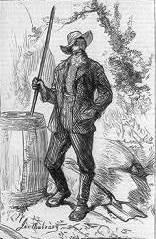
Mountain whites were white Americans living in Appalachia and the inland region of the Antebellum South. They were generally small farmers, who inhabited the valleys of the Appalachian range from western Virginia spanning down to northern Georgia and northern Alabama.

Appalachian music is the music of the region of Appalachia in the Eastern United States. Traditional Appalachian music is derived from various influences, including the ballads, hymns and fiddle music of the British Isles, the African music and blues of early African Americans, and to a lesser extent the music of Continental Europe.
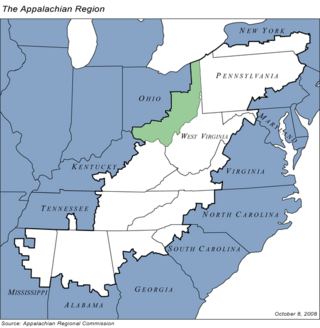
Appalachian Ohio is a bioregion and political unit in the southeastern part of the U.S. state of Ohio, characterized by the western foothills of the Appalachian Mountains and the Appalachian Plateau. The Appalachian Regional Commission defines the region as consisting of thirty-two counties. This region roughly overlaps with the Appalachian mixed-mesophytic forests, which begin in southeast Ohio and southwest Pennsylvania and continue south to Georgia and Alabama. The mixed-mesophytic forest is found only in Central and Southern Appalachia and eastern/central China. It is one of the most biodiverse temperate forests in the world.

In the United States, the Hillbilly Highway is the out-migration of Appalachians from the Appalachian Highlands region to industrial cities in northern, midwestern, and western states, primarily in the years following World War II in search of better-paying industrial jobs and higher standards of living. Many of these migrants were formerly employed in the coal mining industry, which started to decline in 1940s. The word hillbilly refers to a negative stereotype of people from Appalachia. The term hillbilly is considered to be a modern term because it showed up in the early 1900s. Though the word is Scottish in origin, but doesn't derive from dialect. In Scotland, the term "hill-folk" referred to people who preferred isolation from the greater society and the term "billy" referred to someone being a "companion" or "comrade". The Hillbilly Highway was a parallel to the better-known Great Migration of African-Americans from the south.

Appalachian studies is the area studies field concerned with the Appalachian region of the United States.
Urban Appalachians are people from or with close ancestral ties to Appalachia who are living in metropolitan areas outside of the region. Because migration has been occurring for decades, most are not first generation migrants from the region but are long-term city dwellers. People have been migrating from Appalachia to cities outside the region ever since many of these cities were founded. It was not until the period following World War II, however, that large-scale migration to urban areas became common due to the decline of coal mining and the increase in industrial jobs available in the Midwest and Northeast. The migration of Appalachians is often known as the Hillbilly Highway.
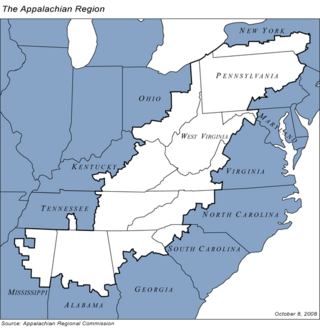
Appalachia is a geographic region of the Eastern United States. Home to over 25 million people, the region includes mountainous areas of 13 states: Mississippi, Alabama, Pennsylvania, New York, Georgia, South Carolina, North Carolina, Tennessee, Virginia, Kentucky, Ohio, Maryland, as well as the entirety of West Virginia.

The Appalachian region and its people have historically been stereotyped by observers, with the basic perceptions of Appalachians painting them as backwards, rural, and anti-progressive. These widespread, limiting views of Appalachia and its people began to develop in the post-Civil War; Those who "discovered" Appalachia found it to be a very strange environment, and depicted its "otherness" in their writing. These depictions have persisted and are still present in common understandings of Appalachia today, with a particular increase of stereotypical imagery during the late 1950s and early 1960s in sitcoms. Common Appalachian stereotypes include those concerning economics, appearance, and the caricature of the "hillbilly."
The city of Baltimore, Maryland includes a significant Appalachian population. The Appalachian community has historically been centered in the neighborhoods of Hampden, Pigtown, Remington, Woodberry, Lower Charles Village, Highlandtown, and Druid Hill Park, as well as the Baltimore inner suburbs of Dundalk, Essex, and Middle River. The culture of Baltimore has been profoundly influenced by Appalachian culture, dialect, folk traditions, and music. People of Appalachian heritage may be of any race or religion. Most Appalachian people in Baltimore are white or African-American, though some are Native American or from other ethnic backgrounds. White Appalachian people in Baltimore are typically descendants of early English, Irish, Scottish, Scotch-Irish, and Welsh settlers. A migration of White Southerners from Appalachia occurred from the 1920s to the 1960s, alongside a large-scale migration of African-Americans from the Deep South and migration of Native Americans from the Southeast such as the Lumbee and the Cherokee. These out-migrations caused the heritage of Baltimore to be deeply influenced by Appalachian and Southern cultures.
The city of Chicago, Illinois is home to a significant Appalachian population. The Appalachian community has historically been centered in the neighborhood of Uptown. Beginning after World War I, Appalachian people moved to Chicago in droves seeking jobs. Between 1940 and 1970, approximately 3.2 million Appalachian and Southern migrants settled in Chicago and elsewhere in the Midwest. Due to immigration restrictions in the 1920s, personnel managers in Chicago encouraged working-class migrants from the Upland South to fill those jobs. The culture of Chicago has been significantly influenced by the culture, music, and politics of Appalachia. The majority of people of Appalachian heritage in Chicago are white or black, though Appalachian people can be of any race, ethnicity, or religion.
The Metro Detroit region of Michigan is home to a significant Appalachian population, one of the largest populations of Urban Appalachians in the United States. The most common state of origin for Appalachian people in Detroit is Kentucky, while many others came from Tennessee, West Virginia, Virginia, Ohio, and elsewhere in the Appalachia region. The Appalachian population has historically been centered in the Detroit neighborhoods of Brightmoor, Springwells, Corktown and North Corktown, as well as the Detroit suburbs of Hazel Park, Ypsilanti, Taylor, and Warren. Beginning after World War I, Appalachian people moved to Detroit in large numbers seeking jobs. Between 1940 and 1970, approximately 3.2 million Appalachian and Southern migrants settled in the Midwest, particularly in large cities such as Detroit and Chicago. This massive influx of rural Appalachian people into Northern and Midwestern cities has been called the "Hillbilly Highway". The culture of Metro Detroit has been significantly influenced by the culture, music, and politics of Appalachia. The majority of people of Appalachian heritage in Metro Detroit are Christian and either white or black, though Appalachian people can be of any race, ethnicity, or religion.















